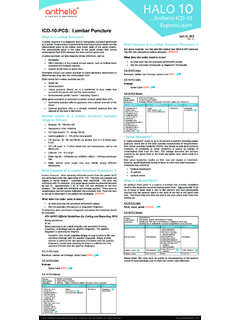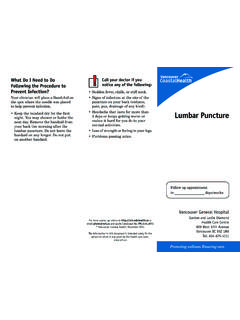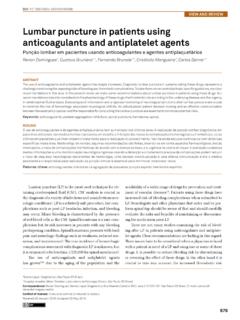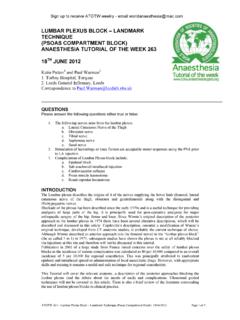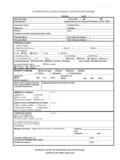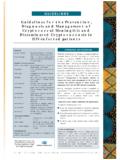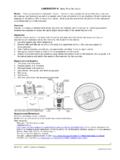Transcription of 181 Post dural puncture headache - Anaesthesia UK
1 Sign up to receive ATOTW weekly - email ! EFFECTIVE MANAGEMENT OF THE post . dural puncture headache . Anaesthesia TUTORIAL OF THE WEEK 181. 31ST MAY 2010. ! Dr Nicola Jane Campbell FRCA. Specialist Training Registrar in Anaesthesia Peninsula Deanery Correspondence to ! ! QUESTIONS. Before reading this tutorial, try to answer the following questions. The answers can be found at the end of the article, together with an explanation 1. Which of the following statements is correct? a. Bed rest and IV fluids should be instituted following accidental dural puncture b. Spinal needle type and size is irrelevant in predicting development of PDPH. c. Epidural blood patch cures post - dural puncture headache in 90% of cases d. The incidence of PDPH following spinal Anaesthesia is < e. An abdominal corset and laxatives are recommended after dural puncture 2. Describe how you would perform an epidural blood patch. 3. Postulated reasons for headache following dural tap include: a.
2 Cerebrospinal fluid (CSF) leak resulting in reduced intracranial pressure b. Downward traction on pain sensitive intracranial structures c. Cerebral venodilatation d. Raised intracranial pressure ! INTRODUCTION. Toward the evening I was forced to take to bed and remained there for nine days, because all the manifestations recurred as soon as I got up. At midnight a violent headache set in that quickly became insupportable.. August Bier 1898 a personal experience of post - dural puncture headache . post - dural puncture headache (PDPH) was first described by August Bier in 1898 and classically presents as a postural headache following therapeutic or diagnostic interventions of the epidural or spinal space. The incidence of PDPH is estimated to be between 30-50% following diagnostic or therapeutic lumbar puncture , 0-5% following spinal Anaesthesia and up to 81% following accidental dural puncture during epidural insertion in the pregnant woman. Although PDPH usually resolves spontaneously, it is unpleasant, it may interfere with a new mothers ability to care for her newborn and it may extend the length of hospital stay.
3 More rarely PDPH may be associated with serious complications such as subdural haematoma, seizures and saggital sinus thrombosis. Effective treatment is limited so measures including the use of suitable needles and acquisition of appropriate skills in spinal and epidural placement are essential to reduce the development of PDPH. ATOTW 181 post dural puncture headache 31/05/10 Page 1 of 7. Sign up to receive ATOTW weekly - email ! PATHOGENESIS AND ANATOMY. The pathogenesis of PDPH remains unclear but is thought to be caused by CSF leakage into the epidural space via a tear in the dura. CSF loss leads to a reduction in intracranial pressure and downward traction on pain-sensitive intracranial structures, including veins, meninges and cranial nerves, resulting in a headache that is classically worse in the upright position. The fall in intracranial pressure may also cause compensatory cerebro-vascular venodilation and this may contribute to the development of the headache .
4 Figure 1: Anatomy of the Dura Mater Illustration Chris Gralaap DIAGNOSIS AND DIFFERENTIAL DIAGNOSIS. The fundamental principle in the assessment of any parturient with a post -partum headache is to carefully consider the differential diagnosis. Table 1: Causes of post -partum headache Infective Pharmacological/Metabolic Meningitis Dehydration Encephalitis Caffeine withdrawal Vascular Other Migraine post - dural puncture headache Cerebral vein thrombosis Pre-eclampsia Cerebral infarction Tension headache Subdural haematoma Benign intractranial hypertension Subarachnoid haematoma Pneumocephalus Lacatation headache Neoplastic Space occupying lesion A history and examination should be performed taking account of the timing of the headache in relation to the neuraxial procedure, the nature of the headache as well as other symptoms and signs. Since PDPH can present following an unrecognised dural puncture with an epidural needle or epidural catheter, details of the epidural insertion should be reviewed including the difficulty of the procedure and number of attempts.
5 In the case of a headache following a spinal procedure, PDPH is more likely following dural puncture with a larger gauge cutting' tipped needle (see later) or after multiple attempts at spinal block which might result in a number of dural tears ( pepper potting' of the dura), increasing the chance of a CSF leak. ATOTW 181 post dural puncture headache 31/05/10 Page 2 of 7. Sign up to receive ATOTW weekly - email ! The cardinal features of PDPH as defined by the International headache Society are a headache that develops within 7 days of dural puncture and disappears within 14 days; however PDPH has been reported to occur later and continue for longer than these times. Classic features of the headache caused by dural puncture are listed below but presentation is often variable. headache is often frontal-occipital. Most headaches do not develop immediately after dural puncture but 24-48. hours after the procedure with 90% of headaches presenting within 3 days.
6 The headache is worse in the upright position and eases when supine. Pressure over the abdomen with the woman in the upright position may give transient relief to the headache by raising intracranial pressure secondary to a rise in intrabdominal pressure (Gutsche sign). Associated symptoms that may be present include neck stiffness, photophobia, tinnitus, visual disturbance and cranial nerve palsies. The skin over the epidural or spinal puncture site should be inspected for CSF leak, inflammation and tenderness. Baseline observations of heart rate, blood pressure and temperature should be recorded. PDPH is primarily a clinical diagnosis however if there is concern that the headache may be related to more serious intracranial pathology then diagnostic imaging should be considered early. In cases of PDPH, MRI may demonstrate diffuse dural enhancement and brain descent. PREVENTION. Spinal Needle Selection Smaller gauge spinal needles with pencil point tips such as the Whitacre and Sprotte needle are associated with lower rates of PDPH.
7 Pencil point needles part rather than cut the dural fibres, and so the hole in the dura closes more quickly. Ideally, spinal needles no larger than 25G should be used. ! Figure 2: Spinal Needle tips Neuraxial Block Technique Epidurals can be inserted using a loss of resistance to saline (LORS) or to air (LORA.) Loss of resistance to saline performed with continuous pressure on the syringe plunger may have the effect of moving the dura anteriorly as the needle approaches thereby reducing the likelihood of dural puncture compared with an intermittent pressure technique with air. In addition, inadvertent dural tap while using LORA may result in pneumocephalus which itself can cause headache . Despite suggestions that ATOTW 181 post dural puncture headache 31/05/10 Page 3 of 7. Sign up to receive ATOTW weekly - email ! LORS is preferable to LORA, a recent retrospective study found that when anaesthetists used their preferred technique, whether air or saline, there were fewer attempts at insertion, less parasthaesia and fewer unintentional dural taps.
8 Orientation of the bevel of the spinal or epidural needle during insertion has been suggested to influence PDPH in the event of an inadvertent dural tap. There is weak evidence to indicate a lower incidence of headache if bevel orientation is parallel to dural fibres, however the exact orientation of dural fibres is unclear. Subsequent rotation of an epidural needle to allow catheter placement may itself be associated with higher rates of dural puncture so the benefits of a parallel' needle approach are unclear. While there is no evidence that inadvertent dural puncture is less likely with an 18G Touhy needle compared with a 16G, in the event of a dural tap, the incidence of headache may be reduced. Other precautions should include ensuring an optimal patient position, slow controlled advancement of the needle and limiting patient movement during the procedure (especially important during labour) by using adequate local anaesthetic infiltration and maintaining verbal contact throughout.
9 Operator experience is inversely related to inadvertent dural puncture and PDPH rates. Fatigue, haste, shift work and stress are other important factors which may contribute to PDPH. After accidental dural puncture with a Tuohy needle, placement of the epidural catheter through the dural perforation may reduce the likelihood and severity of PDPH. This is thought to be due to the spinal catheter invoking an inflammatory response, which promotes healing of the dural tear and further reduces CSF leak. Randomised trials of the effectiveness of placing a spinal catheter are limited, evidence is conflicting, and how long the catheter should be left in place is unclear. The risks of leaving an intrathecal catheter include infection and drug overdose and hence the catheter should be clearly labelled. If staff are familiar with their use, the placement of an intrathecal catheter after unintentional dural puncture may be preferable to repeated attempts at epidural insertion.
10 Following diagnostic lumbar puncture , replacing the stylet prior to removing the needle may reduce the risk of headache . Insertion of the stylet may prevent a strand of arachnoid that was trapped in the needle following CSF aspiration from being avulsed on needle withdrawal thereby reducing damage to the dura. MANAGEMENT. Cons erv ati ve Ma na ge m e nt Most post - dural puncture headaches will resolve spontaneously. Conservative management has traditionally involved bed rest and fluids though there is little evidence to support either of these measures. A recent Cochrane review concluded that routine bed rest after dural puncture is not beneficial and should be abandoned. While routine administration of additional fluids may be unnecessary, avoidance of dehydration is advisable to help limit headache severity. Pha rm ac ol ogi c al Many drugs have been recommended to treat PDPH, however in the vast majority of cases, evidence of effectiveness is limited.










